newsltr
NSPCB Newsletter - Fall, 2000.
Sunday October 22, 2000 at 12:00 noon This is the Annual meeting and is being held on the 22nd. It will be held as usual at the French King Restaurant on Route 2 in Millers Falls, Mass. The program for the day will be a duel projector showing of Canadian Covered Bridges, entitled "Canada's Links to the Past" set to music and narration. Dick Roy will be doing the program.
Sunday November 26, 2000 at 1:00 This meeting is scheduled for the Pilgrim Church in Framingham, Mass. On the East side of Edgell Road (Route 30 in Framingham, Mass.) This location is just North with Route 9. It is located on the right hand side or the East side as you are traveling North from route 9.This will be our last meeting for this year. There is always plenty of parking for this meeting place.
Sunday March 25, 2001 at 1:00 This meeting is also scheduled for the Pilgrim Church in Framingham, Mass. The directions are the same as above.

Topics, Fall, 2000:
Dear Fellow Members, Greetings!
Though I find it hard to believe, yet it is
true: Summer is once again just about over. Perhaps my inability to accept the imminent demise of
Summer is a phenomenon linked somehow to advancing age - - mine, of course!! - - but with each
year that passes, the seasons seem shorter to me.
I am reminded of the great French
writer Colette, who, as she grew older, often remarked she was at the stage of life where the lamp
beside her bed did not shine quite as bright as it should, nor did the doorbell ring as loud as
it once had.
Well, dear readers, (And here I show
my age yet again: when was the last time any of you saw the phrase, `dear readers' in a
contemporary novel?!) have no fear: I can still hear the doorbell and read by the light of my lamp,
even it I do find the seasons shorter.
I can't write like Colette, however, but
then, I never could!
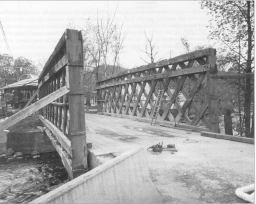 And now to the bridges!
And now to the bridges!As mentioned in previous President's Messages, I plan on these pages to begin a fairly thorough discussion of the various preservation issues raised by recent treatment of our covered bridges over here in Vermont.
It should be noted, however, that though much of what follows will be centered upon events having occurred in Vermont, the events in question often reflect practices elsewhere, and in any case have undeniable national implications.
A good place to start the discussion is probably with the photograph which appears on the front cover of the current issue of Topics, the one in which this President's Message has been inserted. As the caption of that photograph states, in it, we are witnessing the last moments of the historic Fuller Covered Bridge in Montgomery, Vermont. This span, about fifty feet long at the floor, was built in 1890, at least according to our records, and crossed the South Branch of the Trout River.
Now it is gone forever, like the Paper Mill and Henry Covered Bridges over in Bennington, and, in my opinion, for as little reason.
In its place, a so-called "replica" of the ancient span is to be erected, thus justifying the acts of vandalism above referred to, at least in the minds of the Vermont Agency of Transportation bureaucrats who presumably authorized what has taken place.
I should note here that by no means is the former Fuller Covered Bridge to be the last of a most unfortunate series. Soon to be added to the list is the historic Williamsville Covered Bridge over the Rock River in the town of Newfane. This span, built in 1870, once again according to our records, has already undergone the indignity of two previous "revisions" and "improvements", both authorized and approved by the Vermont Agency of Transportation and the Vermont Division for Historic Preservation. The third revision has been designed to prove fatal, another version of three strikes you're out I guess.. I quote from the Wednesday, March 8t' 2000 issue of the Brattleboro Daily Reformer:
"Voters chose heritage and aesthetics over modern convenience Tuesday, as they overwhelmingly approved a plan to re lace the aging, single-lane Williamsville Covered Bridge with one of the similar design. (Underlining mine)
An interesting Preservation Philosophy, that!!! Preservation through Demolition. In ones mind's ear one can almost hear the publicity campaign: "Demolish today so that future generations can enjoy the treasures of the past". Repeated enough times, it would surely prove a great success.
In any case, the Reformer Article goes on to say, "Once authorized, .... the bridge project would begin in 2005, and take several months to complete." Members enamored of this span had thus better hurry up and get over there to pay their last respects. During the course of such visits, it will also be possible to admire the four great "Glue-Laminated" beams which have recently been inserted in the structure, placed there to safeguard said structure until demolition, presumably. This most recent "revision" and `improvement" is reminiscent of the "reservation Option" selected for the Kidder Covered Bridge over in Grafton, Vermont, albeit less elegant.
To return to the case of the demolition of the Fuller Covered Bridge, two very obvious questions suggest themselves; to wit: 1) can what occurred there in Montgomery in any way be called "Preservation", and 2) was it necessary for imperative structural reasons to take down the Fuller Covered Bridge?
Let us take the first question first.
In this context, I am going to remind all of you of something I wrote in my previous President's Message, the one which accompanied the Summer issue of Topics. If you will remember, for purposes of examining "Preservation Philosophy", I defined a Covered Bridge in that issue in a somewhat abstract fashion. I said that a Covered Bridge is particular materials arranged in a particular manner by a particular person for a particular purpose at a particular time; further, I stated that a Covered Bridge had been "Preserved" to the extent that it retained all or most or anyhow a goodly proportion of its original non-wearing parts, had not been revised or improved out of existence through radical changes to its original design, and was still being used more or less as originally intended.
Obviously, the former Fuller Covered Bridge cannot meet any of the above conditions - it no longer exists, not to belabor the point - so its removal in no way constitutes an act of preservation, but rather one of destruction, or as I should prefer to say, of vandalism.
To be continued next issue.
Happy Bridging. Your President, David W. Wright

Covered Bridge News
By Bob and Trish Kane
Delaware County:
• Downsville Covered Bridge - NY 32-13-01 The new Covered Bridge Park has been a huge success not only with the residents of Downsville but residents in surrounding villages. Labor Day weekend brought many visitors to the bridge and the park. Picnic lunches were plentiful and many folks launched boats and canoes taking advantage of the fall foliage by way of the river.
• Hamden Covered Bridge - NY 32-13-03 As many of you know, there was an unfortunate accident with the Hamden Covered Bridge. (For more details or to read the official statement issued by the Delaware County Department of Public Works, see the accompanying article or visit Joe Nelson's web site at www.vermontbridges.com/hamden.move.htm).
Saratoga County:
• Copeland Bridge - NY 32-46-01 All the paperwork has been completed and the Historical Society is now accepting bids for the restoration work on this bridge. Their Buy a Share of History campaign is going well and, to date, they have raised just over $12,000. It is hoped that the restoration work can begin soon, but more funding is needed before that can happen. The folks in Edinburg and the surrounding area are very proud of their bridge, and rightfully so. The Copeland Covered Bridge is the only historic Queenpost Truss remaining in New York State, and the folks there are working very hard to save their bridge. If you would like to help, please contact the Edinburg Historical Society, Ms. Marie Penino, 7 Lakeside Drive, Edinburg, NY 12134 or call her at 518-863-8871.
Ulster County:
• Ashokan/Turnwood Covered Bridge - NY 32-56-05 Good news! On July 20, 2000 the Ashokan/Turnwood Covered Bridge was officially listed on the National Register of Historic Places.

Ohio's McColly Bridge 35-46-01
by Brian McKee
Brian writes on the repairs of the McColly Bridge in Logan County.
I was surprised to see that the previous
contractor (Amos Schwartz Co. of Indiana) was replaced by the Righter Co. of Columbus, Ohio.
I wonder what happened? They (Schwartz) seem to do very good work so I am curious as to why
they were replaced on the job.
The bridge is almost completed from the
looks of it. They are apparently painting the interior with spray guns. In the photo, you can see
the plastic sheeting that they covered the exterior with. It was very windy when I was there and it
was tearing off of the bridge. The exterior will be red, instead of the former white color.
There is a very heavy steel framework
under the bridge and it is tied into the truss with bolts. There was a similar framework under it
before the project started, but it wasn't as elaborate. They have also added two new piers for
some reason. The piers are concrete with fake stone facings.
The lower chords were damaged with
rot and most of the wood in them has been replaced. A lot of the triangular shaped pressure plates
were replaced, too, with a modified design. The rods of the Howe truss look new, but I can't tell
if they are brand new or just painted silver. The old shake roof is still on it, but has been covered
with new "standing seam" metal roof. The floor is made of 2x4 lumber laid edgewise like we see
in many bridges these days.
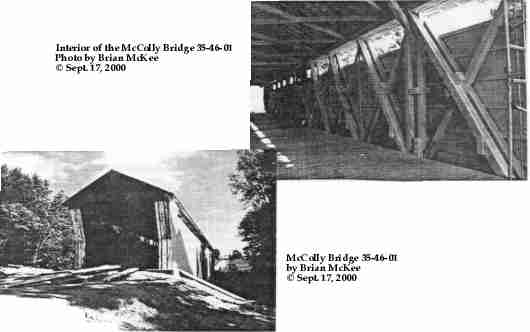

CRESTLINE INDUSTRIES is very proud to be contributing to the preservation of our
heritage by providing a unique, nontoxic permanent fire retardant to hundreds of historic
structures, including over 40 covered bridges, in just the last few years. Our products are also
used in many museums, zoos, aquariums as well as homes, hotels, bed and breakfast retreats, and
public buildings.
As winter approaches, the chance of
accidental home fires increases tremendously. We can all picture many scenarios: ---Logs roll off
a living room fireplace ---An unattended pot sets a kitchen curtain ablaze ---A space heater ignites
a piece of fabric ---An overextended electrical outlet begins to flame behind a wall. You should be
alert for these and many other conditions that put you, your family and your property at risk.
CRESTLINE has a number of products that can help YOU improve the fire safety of your home, your farm, your garage and your business. We welcome you to visit our web site to get more specifics: http://crestline.netrax.net You may also call our toll free number 1-888 EMC-RELY (1-888-362-7359) to specific circumstances. In addition to permanent treatment for structures, furniture, bedding etc. three excellent safety items are: Kitchen Fire Towel (2 ft.x4 ft.), Fire safety Blanket (5 ft.x 5 ft.), Fire Blaster - 16 oz and 32 oz. These can be excellent safety products to have gust in case." They also make very unique and well appreciated gifts!
In special recognition of all the Society does, CRESTLINE is pleased to record that any order placed with CRESTLINE because of this ad will generate a payment to the National Society for the Preservation of Covered Bridges Inc. Thus you can "bridge" your love and appreciation for these timeless reminders of earlier days, with your concern for reducing losses to your everyday world.
P. S. If you are involved with a covered bridge or other historic structure and funding limits are preventing you from treating it with the fire retardant now, let us know. Too many bridges and other buildings have been lost to arsonists and we do not want to see this happen because of a cash shortage among those who care for it! Crestline is willing to arrange payments over time -- with no interest or carrying charges. (An average bridge requires well under $4,000 of the product to treat, and for the interior of the bridge, retreatment will never be required.)
Thank you all. Steven M. Sass, President Crestline Industries 11436 B Cronridge Drive Owings Mills MD 21117 http://crestline.netrax.net

Bridging the Bluegrass State
By Melissa Jurgensen
• Coleville Bridge News: [17-09-03]
In mid June of 1999, Intech Contracting began dismantling the Coleville Bridge in Bourbon
County. Once the bridge was dismantled all of the pieces were laid in a nearby field and inspected.
It was determined that due to the flood damage it received in March of 1997, excessive
overloading and severe insect damage that 95% of the pieces would have to be replaced. (I
inspected the wood at the bridge site myself and the insect damage was very severe.) As much as
possible the original wood will be reused. Many of the pieces will be shifted to nonload bearing
positions.
In December of 1999 The Kentucky
Highway Department had a meeting in which they discussed the best way for the bridge to retain
it's camber (arch) and not sag. The project is different from the Switzer Bridge and Oldtown
because the bridge will carry traffic. The bridge will only actually have a few inches of camber but
it is very crucial to the design. A team of engineers consulted with covered bridge builders in
other states and it was determined that in order for the bridge to retain it's camber the wood
would have to have a precise moister content.
The wood they going to use for the
bridge was shipped from Texas and New York to be dried to the correct moisture content. The
Douglas fir dried very well but the Red Oak Didn't. The fast drying method caused the oak to
honeycomb, and it could not be used. Due to the Douglas Fir's excellent drying performance,
more Douglas Fir will be used than originally planned. The additional wood has been successfully
dried, and it all should be cut the end of August. Once the wood is cut it will be treated with a
non-graffiti coating and coated for insects. The non-graffiti coating is a clear coating that seals the
wood so the paint will not seep into the grain of the wood It will easier to remove.(Those of you
familiar with Colville know that graffiti is a major problem.) Construction should begin soon after
the wood is cut. It is anticipated the project should be completed by the end of the year.
• Walcott Bridge News: [17-12-01]
Due to severe flood damage in recent years it was decided in early 1999 that the bridge would be safer if it is dismantled and kept in storage until it can be restored. Once restored it will be moved to a site about 200 yards upstream to a higher location to prevent further flood damage. The bridge will be the main feature in a park area.

Bv Trish Kane
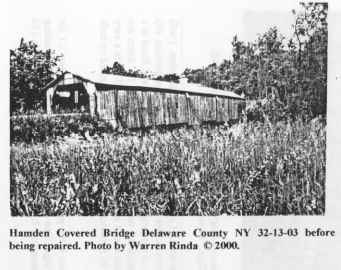
If Robert Murray were alive today, he would have stood on the banks of the west branch of the Delaware River in Hamden, NY on July 19, 2000 in total disbelief at the sight before him. The bridge he so loving and carefully built back in 1859 no longer had a roof, siding or a floor. The magnificent Long truss was now exposed for the entire world to see. Looking on both sides of the river, he would have seen many Hamden residents and spectators from neighboring towns and villages waiting for a seldom seen event - the moving of a covered bridge. I'm sure the mammoth cranes sitting on both sides of the river would have even frightened him to an extent as they sat, waiting for the moving of his beloved covered bridge. I have no doubt that Mr. Murray would have stood in awe and total disbelief. How I would have loved to have stood beside him on July 19th and heard his thoughts as the events of the day unfolded.
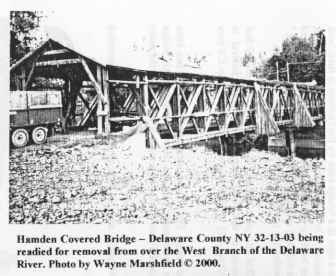
I am sure that most of you are now aware of the unfortunate accident that happened with the Hamden Covered Bridge. Fortunately, no one was hurt. In brief, the load sharing between the two cranes moving the bridge experienced an unexpected load shift. The smaller crane was unable to compensate for the shift and had to let go or topple. The operator did a remarkable job at avoiding loss of life and the crane, but, unfortunately, the top chord in the bridge broke and approximately 1/3 of the bridge had to be lowered into the river. (If you would like to read Delaware County Department of Public Work's official statement, visit Joe Nelson's web site at www.vermontbridges.com/hamden.move.htm)
But much has happened to the Hamden Covered Bridge since July 19th. Now that the bridge is resting on dry ground, a closer inspection of the bridge has been made possible. It has been
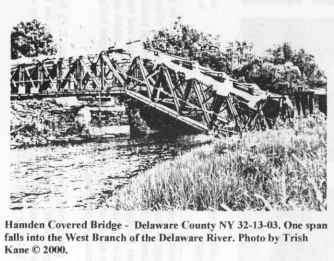 determined that five of the proposed post members that were originally tagged for replacement
will not need to be replaced after all. But it was also found that one post member had hidden
defects and will need to be replaced. Some of the top chord members were also found to have
some hidden imperfections, as well as an additional main diagonal member. The accident damaged
four posts that will be replaced, in addition to 6 (+/-) adjacent top chord members. Efforts are
being made to relocate some of the better existing members (scheduled for replacement due to
high stresses) for replacement with others in worse condition nearer the center of the bridge
where the loads are reduced. Hence, the work is generally going according to plan, and the
accident did not cause significant damage.
determined that five of the proposed post members that were originally tagged for replacement
will not need to be replaced after all. But it was also found that one post member had hidden
defects and will need to be replaced. Some of the top chord members were also found to have
some hidden imperfections, as well as an additional main diagonal member. The accident damaged
four posts that will be replaced, in addition to 6 (+/-) adjacent top chord members. Efforts are
being made to relocate some of the better existing members (scheduled for replacement due to
high stresses) for replacement with others in worse condition nearer the center of the bridge
where the loads are reduced. Hence, the work is generally going according to plan, and the
accident did not cause significant damage.
Work continues daily on the bridge and the site. The county has installed steel sheet piling to assist in preventing underwater erosion from high water events. This piling will be cut off lower following installation of concrete between it and the old footings. The abutments are almost complete and the process or forming the new concrete caps will soon begin The glue laminated bottom chords have arrived and the temporary steel work that will be used to support the roll-in of the bridge will soon be installed. This steel work will be removed after the bridge is back over the river and is in no way permanent.
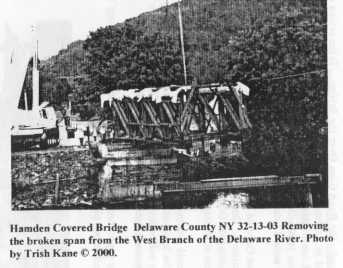
Delaware County officials have been working very closely with the New York State Office of Historic Preservation, and after a review of the initial plans for the restoration work, plus some revisions as a results of the accident, they have now determined that the Hamden Covered Bridge will retain its listing on the State and National Register of Historic Places. Good news indeed! Delaware County officials, Hamden town officials and the State Preservation Office should all be highly commended for their outstanding efforts. They have done a fantastic job of communicating and working together in saving and restoring this bridge.

Usually the Road Goes Over the Bridge... Is the saying on a sign in a bridge
built by the Gratons in their back yard in Ashland. "Probably the most traveled bridge in America,
On it's journey from the Graton's Ashland, NH construction site to the Mall in Washington DC
and then back to Heritage-N.H. in Glen, the bridge logged about 1600 miles. The trip from Glen
to Hopkinton and back will add another 250 miles to the bridge's travels." Ed note: I believe that
the 1600 is the total of the miles including the travel back to Glen.
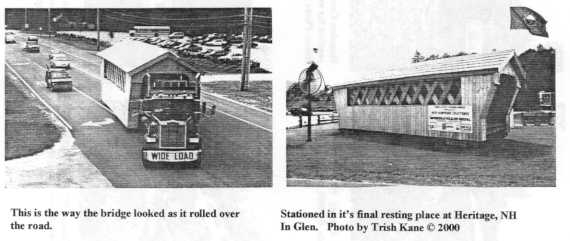 Most Covered Bridges are built on land
and then slowly pulled into place, usually a distance of 100 to 300 feet maximum. Our Covered
Bridge, which was the centerpiece of the New Hampshire Folklife festival in Washington DC.
traveled from it's construction site in Ashland, NH to Washington, DC and then to it's new home
at Heritage.
Most Covered Bridges are built on land
and then slowly pulled into place, usually a distance of 100 to 300 feet maximum. Our Covered
Bridge, which was the centerpiece of the New Hampshire Folklife festival in Washington DC.
traveled from it's construction site in Ashland, NH to Washington, DC and then to it's new home
at Heritage.Arnold Graton Associates of Ashland, NH built the covered bridge. For three generations this family has been in the business of building new or restoring covered bridges and historic post and beam structures. This bridge was built using the Town Lattice truss design, patented by Ithiel Town of [Connecticut]. It was one of the more commonly used truss designs in the 1800's.
The approximate dimensions of the bridge are 36' long 14' wide and 14' feet at peak. The bridge traveled intact in one piece.

There has been a lot of construction in Plymouth, NH on the Smith Covered Bridge by 3 G
Construction. I will attempt to show and describe a portion of the efforts of the contractors. This
is a project of major proportion. 3 G Construction is the contractor for the wooden bridge portion
of the project. All the joints were cut and fitted in a timber framing shop in Unadila, NY.,
transported and reassembled on site in Plymouth. Most of the items are Glue laminated and the
bridge is rated for HS20, which means that it is rated for interstate travel. This is a very large and
strong bridge and is probably the strongest bridge in America. I know of no other that is rated or
built to these specifications.
The construction cost is about 4.4
million dollars. E. D. Sweat is the prime contractor and had bid about 3.1 for the prep work,
abutments and the road approaching the bridge. One of the unusual items is that 100 bearing piles
were sunk, from 120 feet to 160 feet to support the abutments. It has 250,000 board feet of
lumber, is 176 feet in length weighing 425 tons.
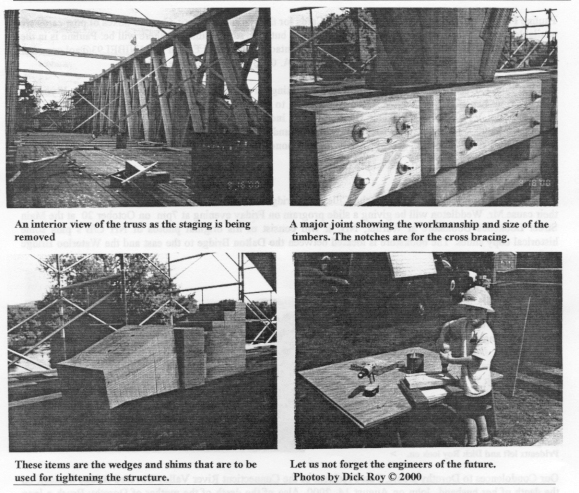

Pauline Prideaux has taken over the sale of Post Cards for the National Society. Over 40 boxes of post cards are available for sale. There are no list available at this time but I am sure in time that there will be. Pauline is in the process of categorizing them. If you have a want list contact Pauline. Her E-mail is SANIBEL93@aol.com. her home address is 143 Freeman Street Ext., Haverhill, MA. 01830-4659. Please be patient.

The Vermont Covered Bridge Society (VCBS) is recruiting for membership in it's new organization. If you are interested in becoming a member, send your dues to The VCBS., Inc Attn: Treasurer P.O. Box 97. Jeffersonville, VT 05464-0097. Their Dues is ($US) Individual Active $10.00 - Family Active $15.00 -Associates $8.00 - Juniors $5.00 - Business $25.00 - and Life members $100.00. If you just want to write to the Society same address accept Attn: Corresponding Secretary. Also visit their Web site: www.vermontbridges.com.

NEW HAMPSHIRE
 David Wright (3rd from left) presents $200 check to Marilyn Stuller,
President of the Langdon Covered Bridge assn. Pauline Prideaux and Dick Roy look on.
→
David Wright (3rd from left) presents $200 check to Marilyn Stuller,
President of the Langdon Covered Bridge assn. Pauline Prideaux and Dick Roy look on.
→The Group looking for funds to repair the Cilleyville bridge in Andover, NH is having a slide show to benefit their cause. Mr. Weddleton will be giving a slide program on Friday evening at 7pm on October 20 at the Main Street Bookends Bookstore in Warner, NH. It will consist of his original photos of NH C/B's plus some historical copy slides. The bookstore is located between the Dalton Bridge to the east and the Waterloo Bridge to the west.
The Langdon Covered Bridge Association held it's annual Fair and road race to raise moneys for the Prentiss and McDermott bridges. A great crowd visited the tents and NSPCB Booth as well as viewing through the boxes of Post Cards that were for sale at the site. Pauline and Don Prideaux were busy volunteering for the Langdon group so June and Dick Roy watched their sales table.

Our Condolences to Dorothy Dobie, Past President of the Connecticut River Valley Covered Bridge Society, on the death of her husband, John on August 14, 2000. Also of the death of the mother of Dorothy Brush a long time member of our society.
Do not forget that the Society has many items to be sold for the Harold Eastman Memorial Fund. The purpose of this fund is used strictly for the preservation of needy covered bridges. June tells me that there are Polo Shirts Medium and Extra Large, with the Humpback Bridge as the logo. These sell for $15.00 plus $3.20 shipping and handling. Also The Society patch and various books by Andy Howard. See previous Newsletters.
Enjoy your fall foliage trips and I hope that you get great shots of our beloved covered bridges. Ed.
 Joe Nelson, P.O Box 267, Jericho, VT 05465-0267, jcnelson@together.net
Joe Nelson, P.O Box 267, Jericho, VT 05465-0267, jcnelson@together.netThis web site page was coded by J.C. Nelson. The content is the intellectual property of the
National Society for the Preservation of Covered Bridges, Inc. and its membership.
This file updated March 18, 2001